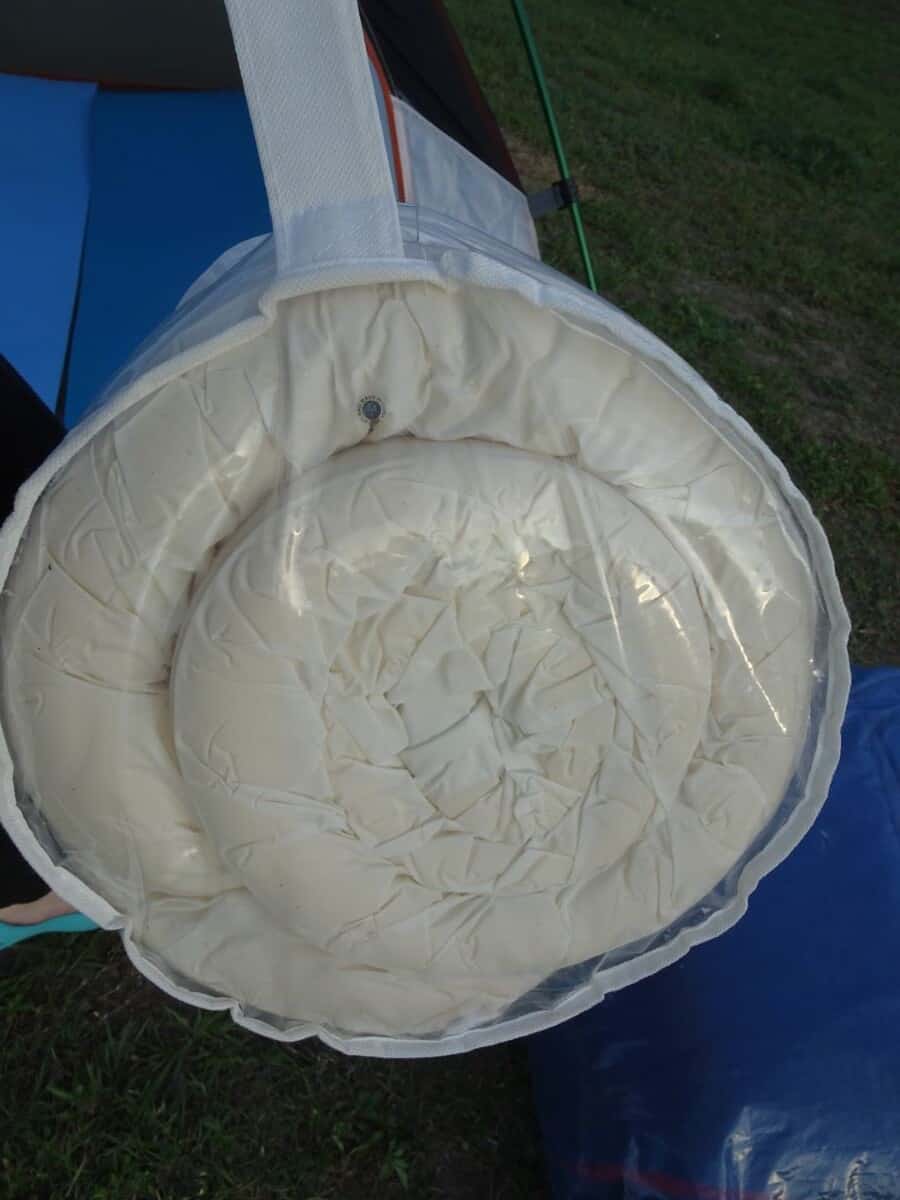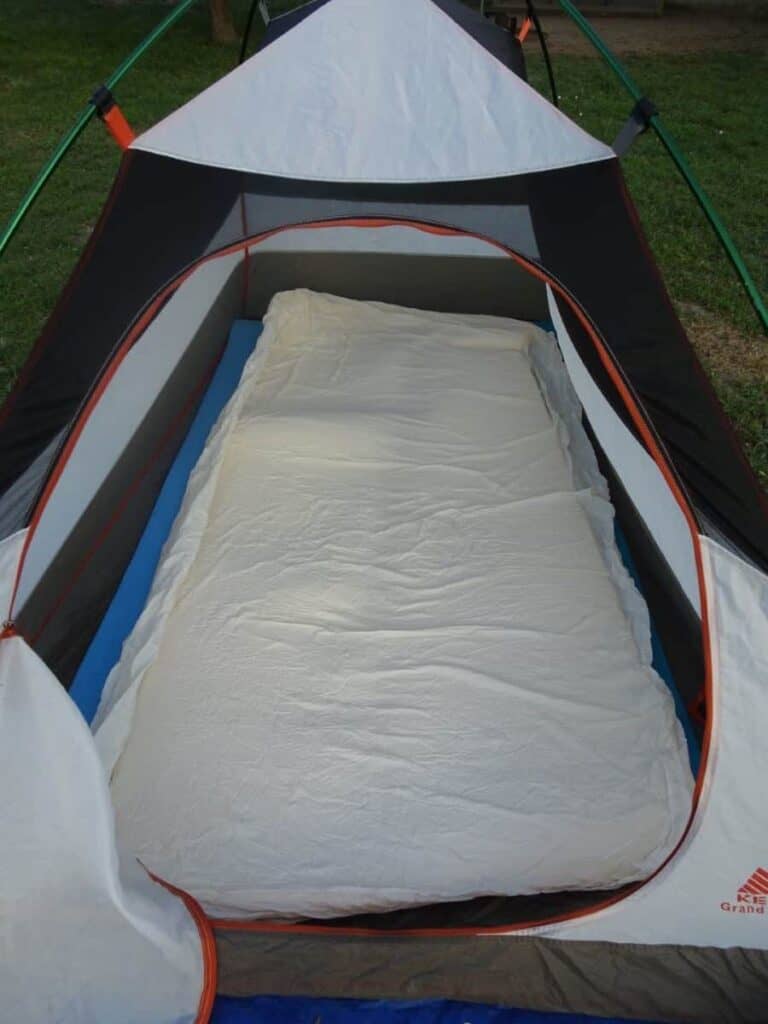Mattress toppers can be a decent way to get some extra comfort while you’re camping.

When you’re using a mattress topper for camping, it’s a good idea to make sure you get something 4 inches or thicker. Also, keep in mind that you may need to adjust for different climates to keep both the bed and yourself at a comfortable temperature.
Naturally, there’s more to learn about mattress toppers and other bedding options for camping. Continue on to take a look!
By the way, as an Amazon Associate, I earn when buying qualified products through links on my site.
Pros and Cons of Using a Mattress Topper
Pros
A mattress topper can be an appealing option when you’re looking to create a comfortable sleeping setup. Often, they are offered in a variety of different thicknesses and can help you to avoid air mattresses that tend to go flat.
Here are just a few of the benefits you can achieve when you opt to use a mattress topper for camping:
- Mattress toppers are less likely to deflate.
- Gel-infused options avoid heat buildup.
- Often easy to roll up and travel with.
- Typically lightweight and easy to adjust.
Cons
While mattress toppers can seem to be a fantastic option, they certainly aren’t perfect. They typically aren’t tools that are designed for using outdoors, so you might find that they aren’t suited to certain aspects of camping.
Here are a few disadvantages of mattress toppers to keep in mind:
- Mattress toppers can harden or soften too much in extreme temperatures.
- They run the risk of being more absorbent.
- The ground surface can change the quality of your sleep experience.
- Toppers can take up more space than small air mattresses.
- Compressed foam can provide less insulation, which can leave you more susceptible to the cold.
You may find that if the ground under your tent is soft, a mattress topper may be plenty to keep you comfortable. However, if the ground is uneven or rocky, then you may have a hard time. As a result, it’s often recommended that you aim for a mattress topper that is thicker than 4 inches. If you need more tips on staying comfortable while camping, you can check out our article on camping comfort here!
Inflatable Air Beds Vs. Mattress Toppers For Camping
Air Beds
Like many other campers out there, I have the most experience using air mattresses. They can be pretty handy, but there are a couple of flaws that can cause a whole lot of frustration.
Air mattresses are designed for camping and other kinds of temporary use. As a result, they tend to be lightweight, easy to store and made from materials that are resistant to the elements within reason.
You can also opt to purchase them in standard bed sizes, making it easy to pick the right size. On top of that, there are varying thicknesses for those who want something that gets them further away from the ground.
However, there are two key issues that air beds can have. To begin with, they can have a nasty habit of developing a leak. Because of this, you’ll want to be prepared to patch leaks at any moment. Additionally, they can have a little trouble staying warm in cold weather. Adding a blanket or two between you and the air bed can help you with staying warm.
Mattress Toppers
There may be any number of reasons a mattress topper might seem like an appealing choice while camping. Maybe you’re tired of deflating air mattresses and want something that won’t leave you sleeping on the ground by morning? I don’t blame you!
Because they tend to be lightweight, mattress toppers can easily seem like a good option to take camping. Yet there are some aspects to be wary of. On their own, they might not provide enough padding to keep you from feeling any bumpy areas on the ground. Furthermore, foam mattress toppers can respond to the climate in uncomfortable ways. They may end up too hard in cold weather, and too soft in the heat.
That’s not to say that mattress toppers are a poor choice by any means. If you get one that is thick enough, you’re sure to get a lot of comfort from it. On top of that, you can also pair it with other kinds of padding. You can take a look at a great mattress topper setup at our article on a DIY sleeping solution.

Which Is Best?
Ultimately, the choice between a mattress topper and an air bed is a subjective one. You’re going to want to consider a few of your camping and sleeping habits before deciding which one to go with.
We can probably assume that if you’re here, you could be more comfortable while you sleep. There’s always room for improvement!
However, you may want to think about what the weather tends to be like where you camp, how often you camp, and what kind of sleeper you are. Are you someone who sleeps on their back, or do you curl up on your side?
Mattress toppers can be more comfortable for back sleepers, while side-sleepers are going to want more cushion between them and the ground. Meanwhile, if you’re looking for a mattress for truck camping then you may want to consider the size you need.
Additionally, think about what you like in a bed. Do you like plush softness or firm structure? This factor is something that can really play into what kind of sleeping surface you need. Whether you choose a mattress topper or an air bed, you’ll want something with plenty of thickness if you tend to like a softer sleeping space.
DIY Ideas For Mattresses For Camping
Multipurpose Foam (Or Egg Crate)
A simple multipurpose foam or egg crate can provide plenty of comfort when you layer it to the ideal thickness. This tends to be a pretty inexpensive solution, assuming you’re not trying to build a mountain of a bed with these materials. This material is perfect for making a DIY foam camping mattress.
Otherwise, you can buy these materials in the right size for your sleeping space, or cut it as needed. Then, you can place your blankets and sleeping bags on top of that.
Just make sure that you keep these materials clean, or you may end up having to replace them more often. Some options may be easier to clean than others, so keep that in mind while you search for the perfect solution.
Some can find that a pre-made foam sleeping pad is ideal, though they may cost a bit more. We talk about some examples of sleeping pads out there in our article here!
Foam Tiles
A solid base you can try out are foam tiles. Now, this concept may bring up images of the kinds of foam tiles you’d find in a child’s room. There’s no rule stating that you can’t use those ones, if you want your tent floor to look like a puzzle. However, there are some more grown-up options as well.
What’s great about these tiles is that they tend to be pretty rubbery and solid, making them easier to clean than some other options out there. That said, they aren’t the softest and may become uneven if the ground is too rocky beneath them.
Bubble Wrap
Although it may not be the most popular option, some may also opt to try out bubble wrap as a potential base for their tent bedding. Typically, this isn’t the most ideal choice but it is one that can work if you need something inexpensive or find that you accidentally forgot your planned bedding base.
If you’re going to try out this route, it’s a good idea to go with something like mylar bubble wrap or other kinds of heavy duty bubble wrap. You may also want to layer it thickly and try to keep anything resting on top of it even.
A problem that can occur is for those who tend to move a lot while sleeping or sleep on their sides. As you can probably imagine, the bubbles in the bubble wrap can pop if they are pressed too hard. You’ll definitely need to be careful!
Make Up A Cot
While the cot itself may not be a DIY project, the way you choose to make it up can be. Cots themselves are a fantastic way to get off the ground and get more air flowing around you. That can help with excess heat, or just keeping you a little bit farther from unwanted pests that may enter the tent.
On their own, cots can be somewhat hard. Because of that, you might decide to pair it with a sleeping pad, foam, or some other base that can allow you to sleep more comfortably.
Most often, cots are found in single-person sizes. However, you can get them in larger sizes for couples. Just keep in mind that they may end up being a little pricey if you aim for something larger.
Try a Hammock!
Those who don’t mind less space for their items can also try sleeping in a hammock. There are hammocks designed with bug nets and the like to keep you protected while you sleep.
Whether you prefer being out in the open air or bundled up, there are options out there that can help. In some cases, there may even be enough space to DIY a little more cushion into your bed situation, although it may not be as needed when you’re sleeping off the ground anyway.
